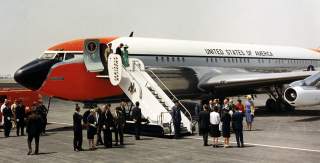'Detachment Hotel': Inside JFK's Top-Secret Tropical Nuclear Bunker
Hiding in plain sight.
In December 1960, the SeaBees – the U.S. Navy’s construction force — supposedly began the mundane task of building a munitions depot behind the Coast Guard station on Peanut Island, Florida.
Known as “Operation Hotel,” the SeaBees actually built a secret nuclear fallout shelter for president-elect John F. Kennedy, who often spent his winters at a nearby estate on Palm Beach.
It took the SeaBees less than two weeks to complete the underground bunker, which consisted of a corrugated steel shelter covered with 25 feet of concrete, earth and lead. Official documents referred to the site as “Detachment Hotel,” and the government didn’t formerly acknowledge its existence until 1974.
Fortunately, Kennedy never had to use the bunker, but it still stands today and has been open to the public for tours since 1999.
It’s certainly no Cheyenne Mountain, Weather Mountain, Greenbrier or those beneath the East and West Wings of the White House. Kennedy’s bunker was positively … tiny.
While in operation, a small thicket of trees hid the shelter’s entrance. A steel door protected it and opened to passageways that housed a generator, air filters and pumps, radiation detectors and a decontamination shower, according to Reuters.
The main room housed 15 bunk beds, a desk and conference table — and a communication center consisting primarily of a ham radio and an escape hatch to a helipad.
Don’t forget food and survival gear. The bunker housed military K-rations, lead-lined cans of drinking water, kits for detecting radiation, waterless hand cleaner, laundry deodorant, petroleum jelly and castor oil, according to the Times.
But the government never intended Kennedy to stay there for very long. Detachment Hotel could shelter Kennedy, up to 30 family members and a group of close advisers for roughly one month.
The bunker is very much a product of the early 1960s … when just about everyone was freaked out by the risk of nuclear war.
In April of 1961, the Bay of Pigs invasion proved to be a disastrous failure for American efforts to overthrow Fidel Castro in Cuba. The Warsaw Pact began constructing the Berlin Wall in August of that same year.
Tensions between pro-Western and communist forces continued to escalate in Southeast Asia. The United Stated deployed Jupiter medium-range ballistic missiles in Turkey and Italy, well within striking distance of Moscow.
The Cuban Missile Crisis would unfold in October 1962 and arguably bring the world closer than it has ever come to the Armageddon. Despite the U.S. possessing a vastly superior nuclear weapons program, both in terms of warheads and deployment systems, American citizens became increasingly paranoid about a supposed “missile gap.”
There was a growing sense that either side could obliterate the other at any given moment. Seventy percent of Americans feared imminent nuclear war in 1960, according to a retrospective Washington Timesarticle.
All combined, the fear set off a bunker-building spree. Americans installed around 200,000 backyard bunkers and fallout shelters by 1965. These shelters ranged widely in terms of style, construction, size and effectiveness.
The simplest bunkers consisted of corrugated metal tubes, reinforced wooden cellars and cast-concrete capsules. On the other end was Las Vegas business executive Gerard Henderson’s extravagant 15,000-square-foot subterranean fallout shelter featuring hot tubs and an indoor swimming pool.
If anyone needed bunkers, it’d be the president. But despite its importance, Kennedy’s tropical shelter had some significant limitations.
“This place wouldn’t have survived a direct hit,” Anthony Miller of the Palm Beach Maritime Museum told VisitFlorida.com, Florida’s official Website for promoting tourism.
The Maritime Museum signed a 45-year lease for the bunker and some of the land around it in 1995. Today, the museum maintains and operates the bunker as one of its exhibits.
“It was a fallout shelter that presumably would have protected them from radiation until a sub or ship could have come to Peanut Island to pick them up,” Miller concluded.
But after Kennedy’s assassination in 1963, the bunker fell into disuse. “The barbed wire that separated it from the Coast Guard station at the southern tip of the island has long since rusted through, and the locks were stolen long ago,” the Fort Lauderdale Sun Sentinel reported in 1993.
At the time, the Maritime Museum planned to clean up and restore the bunker. It turns out the shelter probably got more use as a top-secret party spot than presidential hideout. “It was totally vandalized, the whole thing,” Maritime Museum founder John Grant told the Sun Sentinel.
The newspaper quoted a carpenter who said the clean-up crews found “beer cans and crack pipes.”
George Milidrag, a Detroit automotive engineer with a home in Palm Beach, donated $250,000 to cover the costs of the restoration project. A second restoration project began in 2015 to restore deteriorating pilings in the bunker and to rid the site of termite and mold infestations.
Approximately 12,000 people visit the bunker each year. It does not receive any funding from the government or the Kennedy family. It relies on volunteers for cleaning and maintenance, Reuters noted.
So check it out — if you’re ever near Peanut Island and looking for an atomic-age getaway.
This first appeared in WarIsBoring here.
Image: White House via Wikimedia Commons.

